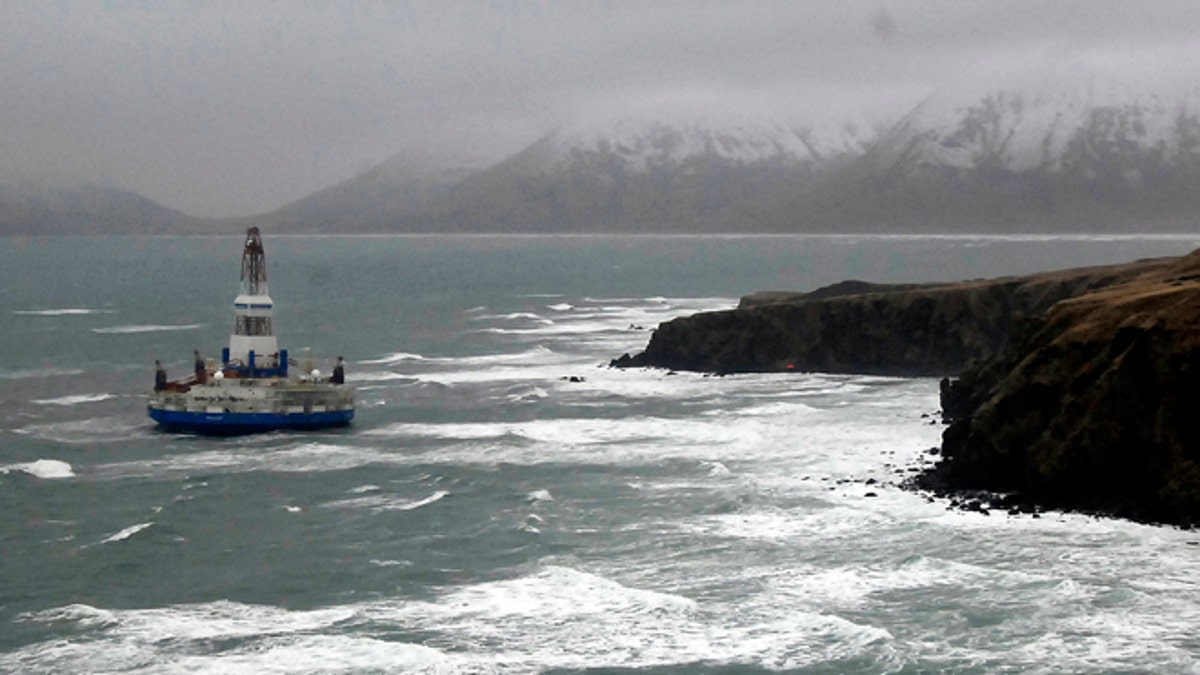
Jan. 2: Royal Dutch Shell drilling rig Kulluk aground off a small island near Kodiak Island (U.S. Coast Guard/AP)
ANCHORAGE, Alaska – Responders on Saturday prepared to hook a main tow line to an oil-drilling ship grounded on rocks near a remote Alaska island.
Officials overseeing the response to the grounding of Royal Dutch Shell's Kulluk barge said they could use the line to "test capabilities" as they prepare to recover the ship.
But the plans were subject to tides and weather, which can be fierce in the North Pacific during winter.
[pullquote]
Officials also hoped to deploy oil-soaking booms around nearby Kodiak Island, especially near any salmon streams. They say there's no sign the hull has been breached or that oil has spilled from the vessel.
The Kulluk ran aground during a fierce year-end storm, and more than 600 people are working on its recovery.
Dan Magone, who has worked on other major groundings in Alaska, said he'd be surprised if they can remove it any time soon.
"I'd really be shocked if this thing is so lightly aground and so lightly damaged that they can just go pull this thing off right away," said Magone, president of Magone Marine, in a telephone interview from his headquarters in Dutch Harbor.
The Kulluk is a circular barge 266 feet in diameter with a funnel-shaped, reinforced steel hull that allows it to operate in ice. One of two Shell ships that drilled last year in the Arctic Ocean, it has a 160-foot derrick rising from its center and no propulsion system of its own.
The vessel was being towed to Seattle last week when a line broke in heavy seas. Re-attached lines broke four more times, and it ran aground New Year's Eve on Sitkalidak Island, less than a mile from Kodiak Island.
Alaska's Department of Environmental Conservation said Saturday that crews had found no sign that the vessel's hull had been breached or that oil had been spilled.
Smit Salvage, the Dutch company hired to salvage the Kulluk, referred calls to Shell, which has said it's too early to predict when the barge might be moved.
Magone is not working on the salvage of the Kulluk but has experience with other major groundings, including the Selendang Ayu, a cargo ship wrecked in December 2004 on Unalaska Island.
Magone's company is under contract for two other wrecks -- fishing boats from which fuel has been removed -- but he's waiting until spring to finish the job.
"The insurance company doesn't want to pay any more money than they have to to get the wrecks out of there, so why risk our equipment and our crew and spend a thousand percent more money playing around in the wintertime when you can just wait until the weather's good and do it then?" Magone said.
"That's pretty normal. Of course with a big fiasco like this, there's all kinds of pressure and everything. But there's a limit to what you can do," he said.
The first salvage crew boarded the vessel Wednesday and assessments continue.
Shell has reported superficial damage above the deck and seawater within that entered through open hatches. Water has knocked out regular and emergency generators, but portable generators were put on board Friday.
The condition of the hull will be key in determining whether the Kulluk can be refloated.
The Coast Guard must review and sign off on a salvage plan. Brian Thomas of the Coast Guard's salvage engineering response team in Washington, D.C., said the team's marine engineers give technical advice and assess risks.

